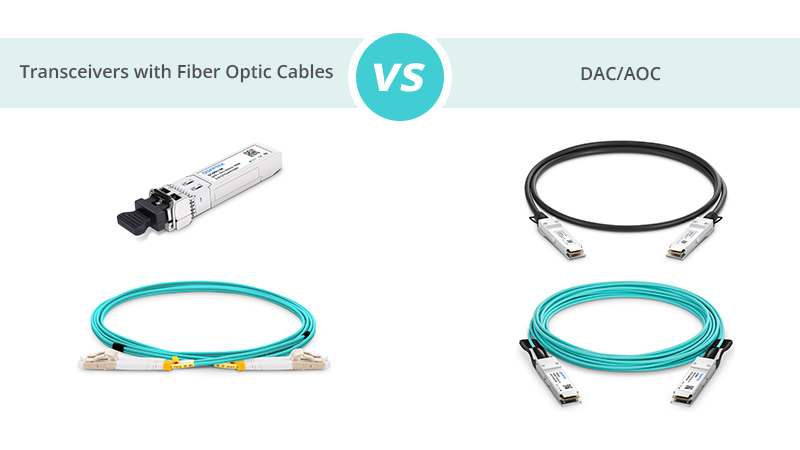DAC/AOC vs. Transceivers with Fiber Optic Cables: What's the Difference?
DAC (Direct Attached Copper), AOC (Active Optical Cable), and transceivers with fiber optic cable solutions are widely used in modern data centers and high-performance network environments. Each solution has its unique advantages and applicable scenarios. However, how to choose the most suitable connectivity solution in different application environments has become the focus of many enterprises. This article will explain the definition of DAC, AOC, and transceivers with fiber optic cable solutions and the advantages and differences between them to help readers choose the best solution according to specific needs.
What is DAC (Direct Attach Cable) and AOC (Active Optical Cable)?
DAC Definition
DAC, or Direct Attach Copper Cable, is a high-performance connectivity solution realized using copper conductor material and high-speed signal transmission technology. It has a fixed-length cable assembly with fixed connectors at both ends, and they cannot be separated. DACs are categorized into passive DACs and active DACs. Passive DACs do not require a power supply to display their characteristics and transmit electrical signals directly, while active DACs require an external power supply to display their characteristics and transmit electrical signals through a driver within the transceiver. DAC Twinax cable can provide a physical connection and high-speed data transfer between devices. By plugging the DAC directly into the device's port, data transfer can be easily performed. It is mainly used to connect ports between devices such as data center equipment, servers, and network switches to provide high-speed, low-latency data transmission.

AOC Definition
Active Optical Cables, or AOC for short, are communication cables that require optical transceiver devices to convert electrical signals to optical signals or optical signals to electrical signals during the communication process, with optical transceivers at both ends of the cable providing photoelectric conversion as well as optical transmission. As a major transmission medium for high-performance computers and data centers, active optical cables ensure transport stability and application flexibility and are more common in high-density applications.

Advantages of These Two High-Speed Cables
Plug and Play: The DAC and AOC are pre-connected, the cables and port interfaces are already fixed together, so users simply plug them into the device with no additional configuration required, making them truly plug-and-play, easy to install, and requiring no complex fiber management.
Energy saving and low power consumption: Especially the DAC, its internal material is copper, the natural heat dissipation effect of copper cable is good, in addition, it has extremely low power consumption, which can help you to reduce costs.
Low transmission loss: The integrated structure minimizes transmission loss and maintains good signal quality.
What is the Optical Transceiver with Optical Fiber Cable Solution?
Explanation of Optical Modules with Fiber Cables Solution
The optical modules + fiber cables solution achieves photoelectric conversion through optical modules and uses fiber optic patch cords to achieve high-speed, long-distance data transmission between devices. Optical modules with fiber optic cables are the most mainstream, this solution can be derived from a multitude of transmission rates and packaging types, widely and flexibly applied in a variety of scenarios.

Advantages of Fiber Optic Modules with Fiber Optic Patch Cords
Flexibility and customization: The combination of optical modules with fiber optic cables is very flexible. Users can choose different types, lengths and specifications of fiber optic cables according to their needs. Fiber optics and optical modules are connected through SC, LC, and MTP/MPO interfaces, which can be flexibly matched according to different network environments and provide personalized solutions.
Easy to maintain: This solution is easy to maintain, and it allows the faulty part to be replaced individually without affecting the other connected parts. This type of maintenance is simple and efficient.
Wide range of application scenarios: The optical transceiver with fiber patch cord solution is widely used in data center interconnection, enterprise network, high-performance computing, cloud service and telecom network scenarios, supporting transmission distances from hundreds of meters to hundreds of kilometers. The solution is applicable to a variety of bandwidth requirements, with rates ranging from 1G to 800G, and interface types including LC, SC, MTP/MPO, etc., which can flexibly meet different transmission distances and rate requirements.
Comparison Between DAC/AOC and Transceiver Modules with Optical Cables

The following table details the differences between these three connection methods.
DAC/AOC Cables and Fiber Modules with Fiber Optic Cords: How to Choose the Right Solution?
Choose AOC: If you need to transmit large-bandwidth data over medium distances and have high requirements for interference resistance and performance, AOC is the ideal choice.
Choose DAC: If the distance to connect devices is short, the budget is limited, and rapid deployment is required, DAC provides a low-cost, high-density solution.
Choose modules with fiber cables: When long-distance transmission is required, flexibility is required, and you want to support multiple application scenarios, this solution is the best choice, especially in complex network environments that require long-distance transmission.
Conclusion
This article compares three network connectivity solutions: DAC (Direct Attached Copper), AOC (Active Optical Cable), and optical transceivers with fiber optic cables. Each of the three solutions has its own strengths and applicable scenarios. Optical module + optical cable is still the most mainstream solution at present. However, how you choose will depend on your specific network needs.











